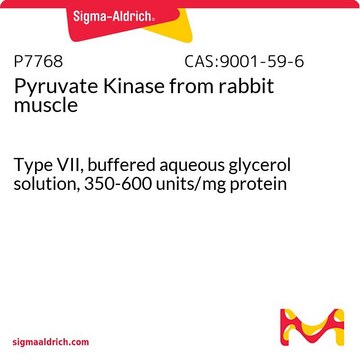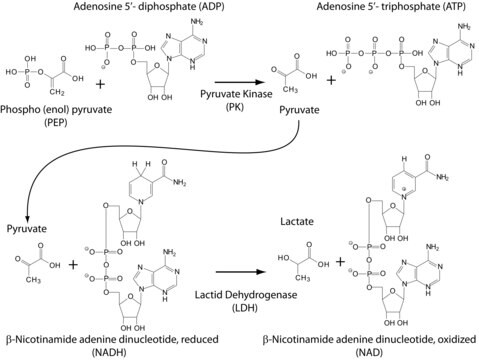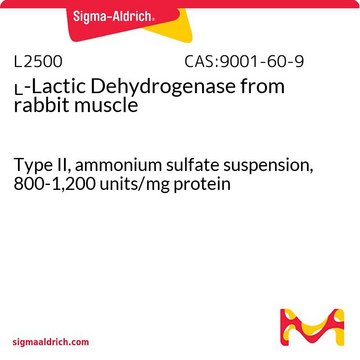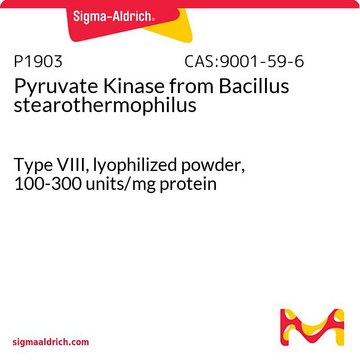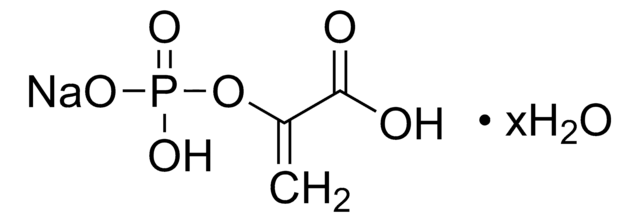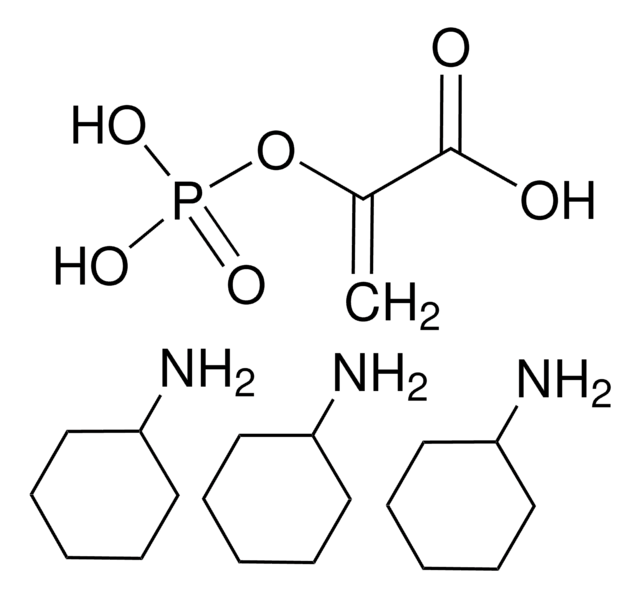10109045001
Roche
Pyruvate Kinase (PK)
from rabbit muscle
Synonym(s):
PK
Sign Into View Organizational & Contract Pricing
All Photos(1)
About This Item
Recommended Products
biological source
rabbit muscle
Quality Level
form
solution
specific activity
~200 units/mg protein (At 25 °C with PEP as the substrate.)
packaging
pkg of 1 mL (10 mg)
manufacturer/tradename
Roche
optimum pH
7.0-7.5
shipped in
dry ice
storage temp.
−20°C (−15°C to −25°C)
Related Categories
General description
Pyruvate kinase has a molar mass of 237,000 and exists as a tetramer. Each polypeptide chain of this tetramer has a molar mass of 57,200. The enzyme contains two identical catalytic particles called protomers. Each of these protomers contains two polypeptide chains. Each protomer contains one site each for Mn2+ and phosphoenolpyruvate.
Specificity
Specific activity: Approximately 200 U/mg at +25°C with PEP as the substrate.
Application
Pyruvate Kinase (PK) has been used as a sample in ATPase Assays.
Pyruvate Kinase (PK) has been used in the kinase assay.
Biochem/physiol Actions
Pyruvate kinase catalyzes the irreversible conversion of P-enolpyruvate and ADP to pyruvate and ATP with the utilization of a proton. The first step is the transfer of phosphate group from P-enolpyruvate to ADP with the formation of bound enolate of pyruvate and ATP. In the second step, a proton is added to enolate to generate the keto form of pyruvate. The enzyme also exhibits other activities, such as ATP- and bicarbonate-dependent ATPase, phosphorylation of fluoride and hydroxylamine, ATP-dependent phosphorylation of glycolate, and decarboxylation of oxaloacetate.
Quality
Contaminants: <0.001% GK, <0.002% HK, “NADH oxidase”, and ATPase, each, <0.01% enolase, LDH, and myokinase, each.
Physical form
Solution in 50% glycerol (v/v), pH approximately 6
Preparation Note
Activator: PK requires Mg2+ (or Mn2+, Co2+) and K+ (or NH4+, Rb+) for full activity.
Other Notes
For life science research only. Not for use in diagnostic procedures.
Storage Class Code
12 - Non Combustible Liquids
WGK
WGK 1
Flash Point(F)
No data available
Flash Point(C)
No data available
Certificates of Analysis (COA)
Search for Certificates of Analysis (COA) by entering the products Lot/Batch Number. Lot and Batch Numbers can be found on a product’s label following the words ‘Lot’ or ‘Batch’.
Already Own This Product?
Find documentation for the products that you have recently purchased in the Document Library.
Customers Also Viewed
Matthias M Schneider et al.
Nature communications, 12(1), 5999-5999 (2021-10-16)
Molecular chaperones contribute to the maintenance of cellular protein homoeostasis through assisting de novo protein folding and preventing amyloid formation. Chaperones of the Hsp70 family can further disaggregate otherwise irreversible aggregate species such as α-synuclein fibrils, which accumulate in Parkinson's
The structure of the R2TP complex defines a platform for recruiting diverse client proteins to the HSP90 molecular chaperone system
Rivera-Calzada A, et al.
Structure, 25(7), 1145-1152 (2017)
In vivo evidence for ATPase-dependent DNA translocation by the Bacillus subtilis SMC condensin complex
Wang X, et al.
Molecular Cell, 71(5), 841-847 (2018)
Metabolic control and structure of glycolytic enzymes. 3. Dissociation and subunit structure of rabbit muscle pyruvate kinase.
M A Steinmetz et al.
Biochemistry, 5(4), 1399-1405 (1966-04-01)
T M Larsen et al.
Biochemistry, 33(20), 6301-6309 (1994-05-24)
The molecular structure of rabbit muscle pyruvate kinase, crystallized as a complex with Mn2+, K+, and pyruvate, has been solved to 2.9-A resolution. Crystals employed in the investigation belonged to the space group P1 and had unit cell dimensions a
Our team of scientists has experience in all areas of research including Life Science, Material Science, Chemical Synthesis, Chromatography, Analytical and many others.
Contact Technical Service

